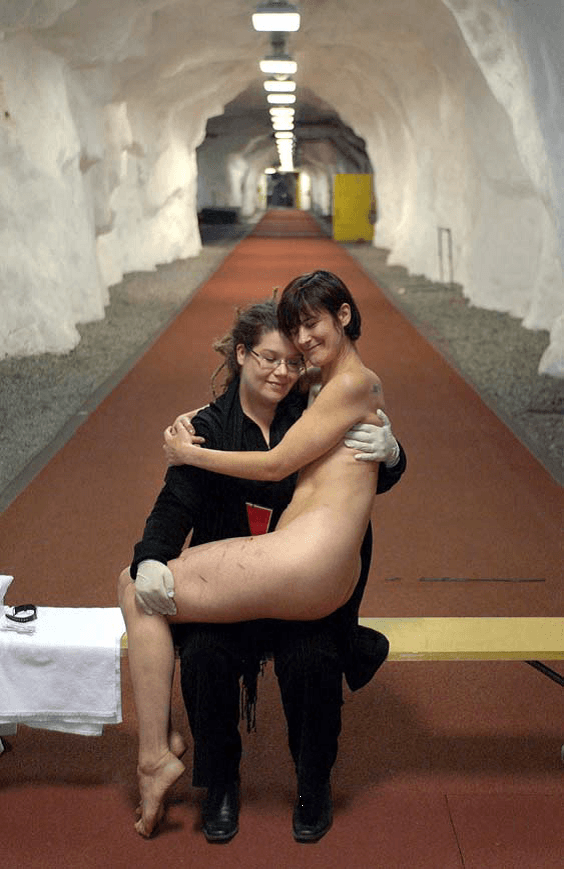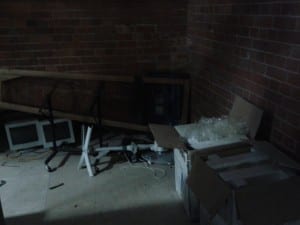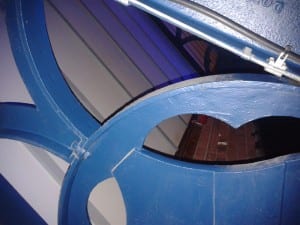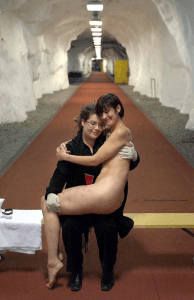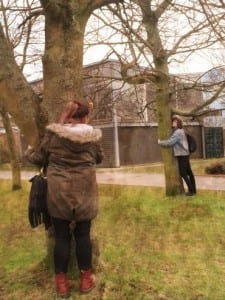Framing statement
The Guardian was a devised site-specific piece which was performed at the Drill Hall theatre, on the 8th of May 2014. The performance took place upon the balcony, which sits directly above the stage in auditorium. The piece was a one on one performance lasting around 5 to 10 minutes, and was performed repeatedly for multiple audiences over a period of three hours.
The Guardian aimed to convey, specifically on an intimate level, what life would have been like on an outpost during the early 1940’s. “Solo performance can address the entangled nature of land, human subject and event, the contested relationships between landscape, experience and identity, and to acknowledge the close link between culture and subjectivity within a given region.” (Pearson, 2011). Because my piece was a solo performance the mechanics of space had to be taken into account, and so I deliberately choose to perform my site piece in a confined space. I felt that my area of the Drill Hall not only represented the aesthetics of an outpost, in the sense that it was high up and decorated by old Victorian brick work, but it was also due to the fact that I wanted my audience members to feel closed off from the rest of the building.
The piece took place upon the balcony, which is situated within the auditorium. Here I sought to recreate a 1940’s outpost, using protections of worn-down walls which were covered in scribbling’s and graffiti to create a military theme. I also thought about the aesthetics of my performance, using tea lights to induce feelings of isolation and loneliness towards the audience. Upon arrival, audience members were greeted by myself and taken up to the performance area, where they where they were instructed to place both hands in an ice bucket. After entering the space the audience member engaged in a narrative monologue, which informed them about what life was like on the outpost.
The piece examined what life was like on a world ww2 outpost. It considered themes of isolation and solitude, by capturing the first hand account of a solider. The idea was formed by due to the fact that the Drill Hall had an outpost on top of the building. This provided the foundations of my piece, as a lot of the general public didn’t know that the Drill Hall played a vital role in defending Lincoln from the Luftwaffe. The performance was a one-to-one experience, made up of narration. I continuously spook directly to the audience telling them my account of what happened.
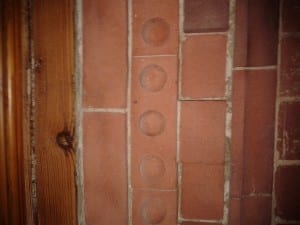
Pinchbeck. M (2015) Brick work.
Analysis of Process
The space it’s self was a difficult one within to work, and posed challenges that needed to be considered. The space was quite narrow and dark; however the darkness was useful for its function in the performance as the outpost. But in terms of the diameter and width on the performance space, I felt that I was limited to what I could do aesthetically. The space was also very warm, which totally went against the theme of my piece. As my goal was to create a piece which would stimulate the audience members into feeling cold. The other challenge was that my performance was in a quite inconspicuous area, and might have led to audience members not entering my space, due to not knowing that it was being used as a performance space. I avoided this by greeting my audience members in person, leading them into the performance area. I toyed around with the idea of space and the role of the spectator. “ This form encourages an investigation of how we might understand ‘site’ as less fixed or less specifically geographical; it broadens the types of relevant ‘spaces’ we might consider. The form also enables us to address a range of performative issues, from the development of site-specific ‘soundscapes’ to the role of the spectator in site-specific performance” (Birch, and Tompkins 2012).
As my site specific performance was war themed, I want the architecture of the building to link with military side of my piece. When I think of war and the military the first thing I think about is heavy machinery and metal. Therefore I want the surroundings of my performance to convey a feeling of coldness. The sealing structure of the Drill hall auditorium shows this, as the metal arches not only transport you back to when the building was built, but they also portray a true sense of Victorian architecture and culture.
The first development in my piece of site-specific performance took place very early one into my first exploration of the Drill Hall. One of the first sessions at the site consisted of me capturing photographs of the site for documentary purposes, and the creation of texts. This was used as a method to capture and archive my initial impressions of the site I was going to be working in. The consideration of space was important, as I need to understand what I could physically do to it. “Some site-specific performance practitioners have similarly come to view space as a layered entity, and their occupations of it as a form o f interpretive spatial practice” (Turner, 1997). Through further research into theoretical approaches to site-specific, I began to consider the importance of creating a monologue, which would then act as the narrative throughout my piece. I finally came to the idea of utilizing accounts of soldiers from the Lincolnshire archives and interweaving them to create the basis for my monologue. Although I couldn’t physically perform my piece in the outpost its self, which is situated on top of the building, I had to instead consider my space as a representation of a space. This led to my belief that “site has shifted from a physical location, to a discursive vector” (Kwon, 2004, 29-30). I wanted the audience members to use their imaginations as “Site uses imagination and site will always inescapably itself be transformed by the disruptive presence of performance seeking a relationship other than that of a ready-made scenic backdrop against which to place its figures.” (Pearson, 2010, p.2) I wanted my site piece to resemble a re-enactment of a solider upon the outpost. I soon started to cement the idea of my piece as a narratological site specific performance, rather than just a physical construction or an installation. Taking into account Fiona Wilkie’s idea of “site as story-teller” (Wilkie, 2002, 158). The Drills Halls rich history provided me with the foundations of my piece. The idea of the representation within site specific theatre is a very wide one and the statement that some spaces provide the performer with problems. Auge explains that, “Contemporary public spaces present particular problems to the performance- maker.” (Auge, 1995) She develops de Certeau’s notion of non-place and defines them as different from what he terms as ‘anthropological places’. This was something I was worried about, as a performer I sought to create a piece which was authentically historical and that clear links could be made to it and the site. As some site pieces, “cannot be defined as relational, or historical, or concerned with identity”. (Auge, 1995).
Following the reading on Why Performance by Mike Pearson, it has been understood that the following reasons why performance can be used as a method for examining and analysing a particular landscape. The landscape is researched and utilised for artistic engagement as a site specific performance.
.He made the following reasons clear why performance can be used in this way:
. Enhancing and informing public appreciation
.Stimulating public imagination
.Performance can bring to life the history and culture of a landscape
.Reacting ‘onto’ (fiction) and ‘from’ (documentary)
.Provide a mechanism for enacting the intimate connection between personal biographies, social identities and biography of place
.To provoke questions about a place
.Shifting from the ‘optic to the haptic’
.Illuminate places that do not easily reveal themselves but which have their own unique characteristics, qualities and attractions.
.Combines creativity and academia
Influences
Mike Pearson’s methods helped me examine my space in artistic way. I begin to think about how to use space to help enhance and inform the public appreciation of my site. I discovered historical facts about the Drill Hall which I myself and others didn’t know. Choosing the balcony as my site space was due to the fact that I wanted to breathe life into a predominantly unused space. The benefits of performing in unconventional spaces are that the audiences expect performances to be in a comfortable, formally structured environment – so by shattering these norms my performance became less passive. It allowed the spectator to access culture and history on a direct level, in a way that conventional theatre spaces cannot. The flexibility and nature of my performance created a platform that increased audience engagement with the cities culture at a grassroots level. Kabosh’s performance style helped me to form more controversial and significant narratives. Kabosh is site specific theatre ensembles who are committed to challenging the notion of what theatre is and where it takes place. I worked with the idea that, “to reinvent the ways in which stories are told, commissioning new writing and devising work for site-specific environments.”(Kobosh, 2011) The specific use of a story teller and the documentation of photographs within my piece consequently produced a cultural tourism element to my performance.
Intimacy
This is relevant because when using narratives within site pieces it is important to make an intimate connection. I felt that intimacy was important in making the audience more engaged in my piece as, “An intimate connection allows our audience or participant to relate the stimulus to their own lives and this will essentially allow them to engage and make the performance their own. (Pearson, 2011) Rachel Zerihan Returning to the Body in One to One Performance highlights the effectiveness of one to one performance. And my rehearsal process consisted of experimenting with the idea that, “One to One performance foregrounds subjective personal narratives that define – and seek to redefine – who we are, what we believe and how we act and re-act (Zerhan, 2006). Zerihan’s principle inspired my piece to be a performance which lifted the audience out of the passive role of an audience member. I wanted The Guardian to allow the audience to schedule ‘alone-time’ with the performer, and thus making it a performance which carried with it the implication that the audience will be able to make it their own – a special-ness composed of intimacy.
The development of my process led me to create a monologue, which was designed to give the spectator an in-depth appreciation of a soldier’s duty upon the outpost. I wanted to convey a humanistic element to my character, allowing the audience to connect with the soldiers on a physiological and emotional level. This shared experience between the actor and spectator hopefully made the audience connect with my performance on a spiritual level. As audience members would find themselves sat on a chair, encircled by six candles, whilst a projection of images of the outpost plays to them. I attempted to identify through the projection of images, details about the Drill Hall that might go unnoticed, and to create a performance that adhered to the idea of photography as an autonomous performative form, and to specifically appeal to the visual senses of the spectator. The Guardians aim was to also stimulate its spectator’s physical senses, as I requested that they place both hands in an ice bucket. My reason behind this was to simulate the audiences into experiencing first hand the extreme cold temperatures that soldiers had to face upon the outpost.
Process.
The drifting exercise proved to be a very profound way for me to create a relationship with space. It allowed me to see objects in a whole new light, in the sense that I didn’t just specifically see them for there functions, but instead I began to view them as shapes and textures. “As the truth of the thing is always somewhere other than in the thing itself” (Salomon and The Crab man, 2010). The method of Drifting allowed me to make a connection with spaces and objects on a social and dynamic level, instead of seeing them for face value, or what society tells us they are.
“It is often thought that the largely rural County of Lincolnshire escaped much damage during WW2. However, this is far from the case; the Luftwaffe carried out bombing raids on our towns throughout the period and casualties were significant” (Felton Morris, 2014. World War 2 civilian causalities in Lincolnshire.). After various trips to the Lincolnshire archives, I was very shocked to find out that areas of Lincolnshire were bombed, and these findings provided me with the basis for my performance, as the use of narration within my piece allowed me to create a meaningful monologue which documented a soldier’s account of life upon the outpost.
The journey of process has been a long one. For instance, the subject matter of my piece required me to convey a specific style, in the sense that it contained elements of ww2. This meant that I had to consider the best artistic approach which would highlight my performance goal. This leads me back to the idea of intimacy. I wanted my piece to make a connection which would allow the audience or participant to relate the stimulus to their own lives, and in doing so and it will essentially have allowed them to engage and made the performance their own. After reading Mike Pearson’s ‘shift from the optic to haptic’ (Pearson, 2011) my process goal was to make the audiences perception change from just seeing to experiencing. I wanted them to leave with the sense that encapsulated an emotional connection with the site. When creating a site specific performance it is very important that the audience make a connection with the site, otherwise they will have not actively engage in it properly. I was very conscious about making my audience experience something meaningful, I didn’t want them to be passive.
Evaluation
On the day of our performance, I had two hours to set up it. Which I used to decorate the performance space. Out of the people that entered the Drill Hall, about twenty took part in the performance. However the ones who did completely immersed themselves within the performance. The spectator gave the impression that specifically the narrative element of my piece worked well, as some of the audiences directly looked at me throughout the duration of the performance with fascination. The costume for my performance was that of a ww2 solider. This was vital in making the whole performance authentic and historically accurate. I feel that the performance itself went very well, to say it was slightly under rehearsed. Nevertheless I felt from the feedback I was given was positive. For instance, all the visual elements of my piece came together, and they specifically reflected the theme of my site performance. I received positive feedback about the stylized way of portraying the soldiers account. Therefore my presentation of the soldiers account drew the audience in and kept their attention. Now moving onto thinks I could have improved on. Firstly I felt that my performance wasn’t really long enough, and I felt that on occasions I seemed to rush it. However due to the nature of it been a narrative based site specific piece, I felt that if the duration was any longer than five minutes, the spectator could have switched off. Furthermore if I was to alter anything in my performance to do it again, I would possibly make the performance more physically interactive. Furthermore I could have found a way of documenting in depth the soldiers account, and specifically linked it more with the site. Working with Site Specific theory and practice has heightened my perception and knowledge of what a performance is and where it can take place. This module has made me realise that a site can be influenced by a number of factors such as social, cultural and environmental elements. Site specific theatre can conjure a number of emotional response to the spectator involved.
Pearson. M (2011) Why solo performance. University of Nottingham.
Wilkle. F (2004) Out of lace. The Negotiation of space in site-specific performance. BA, University of Surrey.
Birch, A. Topkins , (2012) Performing Site-Specific Theatre. Palgrave.
Smith.P (2010) Mythography. A guide to walking side way. Devon. Triarchy Press.
Kobosh.2010
Felton. M, 2014. World War 2 civilian causalities in Lincolnshire.
